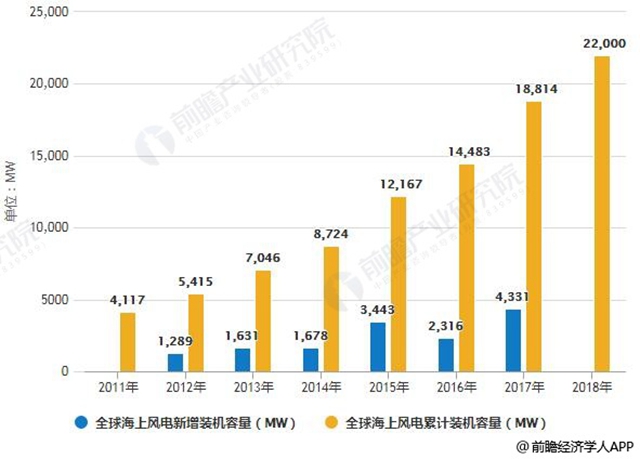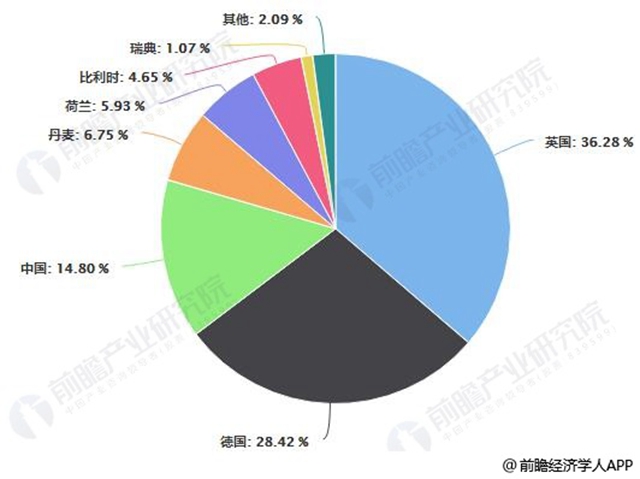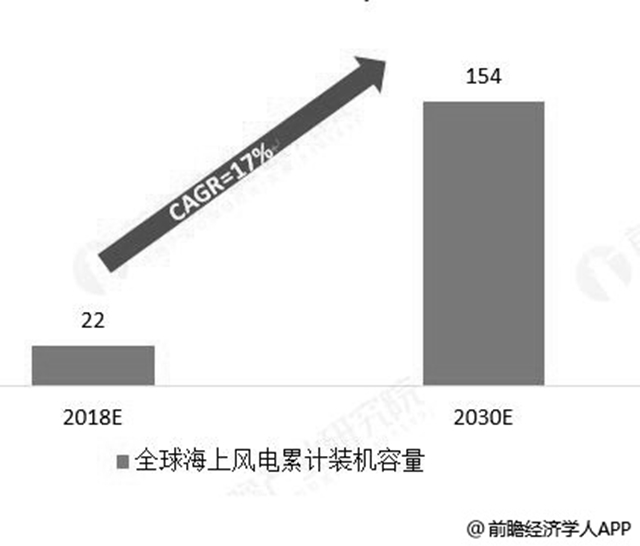Market status and trend Analysis of Global Offshore Wind Energy Industry in 2018
Great Development potential of Offshore Wind energy Industry
The development of offshore wind energy technology has been greatly improved in recent 20 years, but the main problems of offshore wind energy development are high cost and inconvenient installation and transportation. With the maturity of offshore wind energy technology, the cost of offshore wind energy generation will continue to decline. The offshore wind turbine presents the trend of large-scale development. In the shallow sea or offshore area, the single pile foundation is the most widely used structure of offshore wind farm at present. Floating structure is suitable for deep sea area, single fan floating platform is the focus of research at present. The offshore wind farm has been gradually developed into a large and medium-sized wind farm, and the arrangement of units and the control of wind farm have been further optimized.
Offshore wind energy resource is a kind of clean and sustainable energy. With the active support of national policies, the improvement of offshore wind energy technology and the decrease of wind energy development cost promote the large-scale development of offshore wind energy, and the offshore wind energy will be further deepened. A wider range of development and utilization.
Compared with onshore wind energy, the development of offshore wind energy undoubtedly has more potential. If we make a comparison between them, we can find that offshore wind energy is superior to onshore wind energy in energy generation stability, grid access convenience, land saving and so on.
Global offshore wind energy market expands rapidly
With the progress of technology and the decline of cost, the scale of global offshore wind energy market is expanding rapidly. According to the "Forecast and Investment Strategy Planning report on the Development prospects of China's Offshore Wind energy Industry" published by the prospective Industry Research Institute, Global offshore wind energy installed capacity continued to rise between 2011 and 2018. In 2017, installed capacity in the world's nine offshore wind energy markets rose by a historic 4334 MW, up 95 percent from 2016. As of 2017, the cumulative installed capacity of global offshore wind energy reached 18,814 MW, up from 2016 (14384MW). 30%. It is expected that in 2018, according to the preliminary accounting data of Pengbo New Energy Finance and Economics, the global offshore wind energy installed capacity will keep the growth trend of 2017, with the accumulated installed capacity reaching about 22GW, with a year-on-year increase of about 17%. The global wind energy industry is gradually expanding, and the offshore wind energy is gradually moving towards the mainstream energy of the world.
Among them, the United Kingdom has maintained its market leadership, the cumulative installed capacity in 2017 is 6836MW, accounting for 36.3% of the global installed capacity, followed by Germany, with the cumulative installed capacity of 5355MW ranked the second in the world, accounting for 28.42%; China Offshore Wind energy installed 1164 MW in 2017, with a cumulative installed capacity of 2788 MW, ranking third in the world. Other countries, such as Denmark, the Netherlands, Sweden and other places, their offshore wind energy installed capacity has expanded, further development of the industry.
Statistics and Forecast of Global installed capacity of Offshore Wind energy from 2011 to 2018

Data Source: prospective Industrial Research Institute
Global Statistics of Offshore Wind energy installed capacity in 2017

Data Source: prospective Industrial Research Institute
Europe remains the world's largest market for offshore wind energy
Europe has always dominated the field of offshore wind energy, and in 2017 it continued its dominant position. In 2017, it continued its dominant position, set a record 3148MW installation, put into production 17 offshore wind farms, with a new investment of 7.5 billion euros, which can cover 2.5GW capacity. 2018, Europe, The Middle East and Africa account for 60 percent of the world's new offshore wind energy installed capacity.
According to the GWEC's annual report, more than half (53%) of the total installed capacity of offshore wind energy in Europe in 2017 comes from the UK; Germany is the second largest market with 40% of the total capacity in Europe; Belgium accounts for 5% of the total. Finland has opened its first offshore wind farm.
In terms of cumulative installed capacity, the top five installed countries and installed volumes of offshore wind energy in Europe are: 6836MW, 5335MW, 1271MW, 1188MW and 877MW, respectively, in the United Kingdom of Great Britain and Northern Ireland (UK), Germany (Germany), Denmark (1271MW), the Netherlands (1188MW) and Belgium (877MW) in terms of cumulative installed capacity. The top five countries together account for 98% of the installed capacity of offshore wind energy projects in Europe.
Statistics of European Offshore Wind energy installed capacity TOP5 countries in 2017

Data Source: prospective Industrial Research Institute
Forecast of the Development Prospect of Global Offshore Wind energy Industry-the cumulative installed capacity is expected to reach 154GW in the future
In 2018, a number of large offshore wind energy projects were built around the world, and the financing of new offshore wind energy projects was about 17.8 billion yuan in 2018. With the development of global offshore wind energy projects and the rise of new markets, it is expected that the global offshore wind energy market will grow at an average annual average growth rate of about 17% in the next decade, and that the cumulative installed capacity of global offshore wind energy in 2030 will reach 154 GW.
Statistics and forecast of global total installed capacity of offshore wind energy from 2018 to 2030 (unit: GW)

Data Source: prospective Industrial Research Institute
Forecast of the Development trend of Global Offshore Wind energy Industry-the downward trend of Offshore Wind energy Price
At the same time, with the cost reduction brought about by technological progress and the improvement of policy mechanisms, the price of offshore wind energy has become a trend. In 2017, Germany's offshore wind energy project implemented the first "zero subsidy" bidding project. The wind farm will be put into operation as early as 2024; The Netherlands has launched a zero-subsidy bidding project, which will carry out electricity prices no higher than retail prices. According to GWEC forecasts, due to industry maturity, technical and management improvements, increased investor confidence, as well as the introduction and deployment of the new generation of wind turbines with large sweep areas and large energy generation, the offshore wind energy items completed in the next five years or so will be completed. Tariff prices will be half as high as in the past five years, and this trend is likely to continue.
Source: forward-looking Industrial Research Institute



